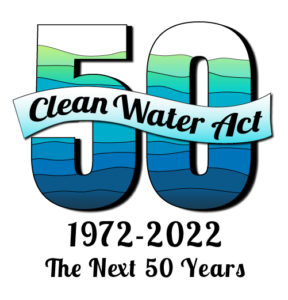Since its founding in 1929, New England Water Environment Association (NEWEA) has been in the forefront of preserving and protecting our region’s precious water environment. As we celebrate 50 years of the Clean Water Act, the most significant legislation passed to protect clean water, it seems a good time to look back at where we’ve been and forward to where we’re headed.
NEWEA has had several names since 1929, including New England Sewage Works Association, New England Water Pollution Control Association, and New England Water Environment Association. Changes in our name over time reflect changes  in the focus of the profession as well as in the broadening of our perspectives, our experiences, and our membership.
in the focus of the profession as well as in the broadening of our perspectives, our experiences, and our membership.
The expansion of our committees and their work also reflects this: of course, and always, collection system and treatment facility design, construction and operations, but also watershed management, nonpoint source control, industrial pretreatment, innovation, and diversity. While NEWEA may have been established with a focus on “sewage works”, it soon turned to embrace a larger view of our water environment and the myriad interrelated impacts on it.
For a detailed account of NEWEA’s history and our involvement with the Clean Water Act since the beginning, see the NEWEA 75th Anniversary Book: Origins and Destinations.
“The American conversation about protecting the environment came to the forefront in the 1960s.” www.epa.gov/history/origins-epa. Rachel Carson’s Silent Spring, published in 1962, warned of the dangers of pesticides. An oil spill off the California coast sent 3 million gallons of oil into the Pacific Ocean. The Cuyahoga River in Cleveland caught fire (again) in 1969. Closer to home, the Merrimack River and Boston Harbor, to name only two of New England’s key water resources, were visibly suffering from decades of pollution and neglect.
It was in this atmosphere that the U.S. Environmental Protection Agency (EPA) was created in 1970. “An environmental ethic is needed,” said the new EPA Administrator, William D. Ruckelshaus in his first speech to the National Press Club. “Each of us must begin to realize our own relationship to the environment. Each of us must begin to measure the impact of our own decisions and actions on the quality of air, water, and soil of this nation.” www.epa.gov/archive/epa/aboutepa/epa-history-1970-1985.html
The EPA was divided into 10 regions, and NEWEA was involved in Region I from the very beginning.
NEWEA’s Legislative Affairs (now Government Affairs) Committee was created in March 1970, one month after members attended the Federation’s seminar in Washington, D.C. In 1972, the Federation held workshops in each of the 10 EPA regions to improve communication between municipal and industry systems managers, consultants, and federal and state officials concerned with implementing the requirements of the 1972 Clean Water Act Amendments. The workshops eventually led to the Government Affairs Committee’s report on “PL 92-500: Certain recommendations of the Water Pollution Control Federation for improving the Law and Administration.” More than 4,000 copies were distributed to the Member Associations, key officials in the EPA and other Federal and State agencies, and to congressional committees and members. (60th Anniversary book, p. 43)
From then on, NEWEA’s interest and involvement in broader water pollution control and water quality issues grew substantially. Our Government Affairs Committee continues efforts to maintain relationships with congressional delegations, to make sure that New England’s water environment issues stay in the forefront.
In 1974, NEWEA hosted public meetings in the format of New England Town Meetings, to explain the provisions of the Clean Water Act. At the same time, NEWEA recognized the importance of establishing ongoing dialogue with members of the New England congressional delegation to apprise them of progress, problems and needs in the abatement and control of water pollution throughout our region. (60th Anniversary book, p. 53)
On March 17, 1983, NEWEA hosted its first Congressional breakfast in Washington, D.C., attended by members of the New England delegation, congressional aides and NEWEA members representing all six states. Since then, the NEWEA Congressional Briefing is the annual hallmark for the Association and its Government Affairs program. It is a great opportunity for our membership and elected officials to join together to discuss water quality and stormwater infrastructure issues facing communities in the Northeast. (60th Anniversary book, p. 54)
Throughout the 1990s and into the new century, each passing decade has seen NEWEA renew its commitment to working with local, state, regional and national partners to ensure that water environment issues – and funding – remain a priority. NEWEA has added several key committees – Contaminants of Emerging Concern, Innovation, Sustainability, Workforce Development to name a few – reflecting the fact that issues and approaches continue to evolve over time. These technical committees collaborate with NEWEA’s Government Affairs Committee to draft policy and position statement papers, which guide the membership, other clean water professionals, and legislative bodies on key issues impacting our water resources.
Most recently, NEWEA created the PFAS Task Force. This Task Force, which is comprised of NEWEA members from each of the six New England states who are also serving on other relevant technical committees, aims to conduct research, create educational materials, and lead outreach with elected officials to promote better understanding of this emerging contaminant, how we are exposed to it, and how we can minimize its impact.
“This collaboration of subject matter experts on the new PFAS Task Force represents NEWEA’s continued commitment to addressing the emerging issues threatening our water quality,” said NEWEA Executive Director Mary Barry. “As we reach this momentous anniversary of the Clean Water Act, NEWEA celebrates this work and the achievements of our members, organization, and industry and reaffirms our mission of advancing knowledge, innovation, and sound public policy for the protection of the water environment and our quality of life.”



No comments yet.